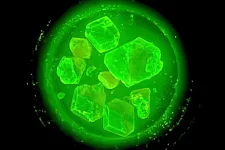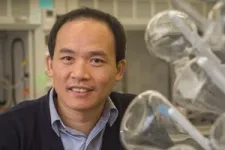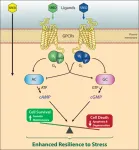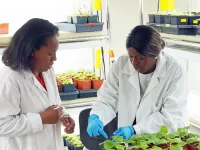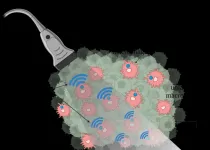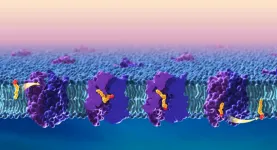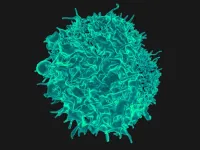(Press-News.org) A team of Florida State University researchers has further developed a new generation of organic-inorganic hybrid materials that can improve image quality in X-ray machines, CT scans and other radiation detection and imaging technologies.
Professor Biwu Ma from the Department of Chemistry and Biochemistry and his colleagues have developed a new class of materials that can act as highly efficient scintillators, which emit light after being exposed to other forms of high energy radiations, such as X-rays.
The team’s most recent study, published in Advanced Materials, is an improvement upon their previous research to develop better scintillators. The new design concept produces materials that can emit light within nanoseconds, orders of magnitude faster than previously developed materials, allowing for better imaging.
“Reducing the radioluminescence decay lifetime of scintillators to nanoseconds is an important breakthrough,” Ma said. “Using a hybrid material made up of both organic and inorganic components means each component can be used for the part of the process where it is most effective.”
WHY IS THIS IMPORTANT?
Scintillators are used in all sorts of imaging applications. Health care settings, security X-rays, radiation detectors and other technologies use them and would benefit from better image quality.
The new generation of organic metal halide hybrid scintillators developed by Ma’s team has numerous improvements over existing ones. In addition to significantly better radioluminescence response, the manufacturing process is simpler than the process used for other scintillators, and it uses abundant and cheap materials.
WHAT’S DIFFERENT ABOUT THIS SCINTILLATOR?
Think of a scintillator as a sort of translator between two types of energy, taking a form of high energy radiation, such as an X-ray, and converting it into visible light. Less radiation passes through denser parts of an object, and that difference can be used to distinguish higher-density objects, such as bones or metal, from lower-density ones, such as soft tissue. The radiation that passes through an object then interacts with the scintillator, which generates visible light that is detected by a sensor to make an image.
Today’s scintillators use mainly inorganic materials to transform high energy radiation into visible light for producing images. These materials are rigid, use rare Earth elements, and require energy-consuming, high-temperature manufacturing processes.
Ma and his team have been working on zero-dimensional organic metal halide hybrids, with which they have performed pioneering research since 2018. These organic-inorganic hybrids are made of small groups of negatively charged inorganic components, called metal halide clusters, and positively charged organic molecules. They’re “zero-dimensional” at the molecular level because the metal halide clusters are fully isolated and surrounded by organic molecules.
In the first version of scintillators based on this material, the metal halides absorb high energy radiation and emit visible light. In this latest iteration, metal halide components and organic molecules work together. The metal halides absorb high energy radiation and transfer energy to the organic components, which emit visible light.
Light emissions from organic molecules take place on the scale of nanoseconds, much faster than the microseconds or milliseconds required for metal halides to emit light.
“The faster the decay of radioluminescence, the more precise we can measure the timing of photon emissions,” Ma said. “That leads to higher resolution and contrast in images.”
WHAT’S NEXT?
With the help of the FSU Office of Commercialization, Ma and his team have filed patents on organic metal halide hybrid scintillators. The office’s GAP Commercialization Investment Program provided funding to develop the technology for potential partnerships with private companies, which would make the scintillators available on a wider scale.
“This is a continuation of our push for better materials over the years, from 2018, when we first discovered this class of materials, to 2020, when we used them for scintillation for the first time,” Ma said. “This is another major breakthrough.”
This study was supported by the National Science Foundation and Florida State University.
This paper’s first author was FSU graduate student Tunde Blessed Shonde. Other co-authors were Maya Chaaban, He Liu, Oluwadara Joshua Olasupo, Azza Ben-Akacha, Fabiola G. Gonzalez, Kerri Julevich, Xinsong Lin, J. S. Raaj Vellore Winfred, all from FSU, and Luis M. Stand and Mariya Zhuravleva from the University of Tennessee, Knoxville.
END
Scintillating science: FSU researchers improve materials for radiation detection and imaging technology
2023-05-08
ELSE PRESS RELEASES FROM THIS DATE:
Webb looks for Fomalhaut’s asteroid belt and finds much more
2023-05-08
Astronomers used NASA’s James Webb Space Telescope to image the warm dust around a nearby young star, Fomalhaut, in order to study the first asteroid belt ever seen outside of our solar system in infrared light. But to their surprise, the dusty structures are much more complex than the asteroid and Kuiper dust belts of our solar system. Overall, there are three nested belts extending out to 14 billion miles (23 billion kilometers) from the star; that’s 150 times the distance of Earth from the Sun. The scale of the outermost belt is roughly twice the scale of our ...
UCI researchers discover new drugs with potential for treating world’s leading causes of blindness in age-related and inherited retinal diseases
2023-05-08
Irvine, CA – May xx, 2023 – In a University of California, Irvine-led study, researchers have discovered small-molecule drugs with potential clinical utility in the treatment of age-related macular degeneration (AMD), diabetic retinopathy (DR), and retinitis pigmentosa (RP).
The study, titled, “Stress resilience-enhancing drugs preserve tissue structure and function in degenerating retina via phosphodiesterase inhibition,” was published in the Proceedings of the National Academy of Sciences.
“In this study, we introduce a new class of therapeutics called ‘Stress ...
First deaf, Black woman receives her PhD in a STEM discipline
2023-05-08
ST. LOUIS, MO - May 8, 2023 – Graduate student Amie Fornah Sankoh recently stood in front of 150 colleagues family and friends at the Donald Danforth Plant Science Center to defend her thesis, Investigating the Effects of Salicylic acid on Intercellular Trafficking via Plasmodesmata in Nicotiana benthamiana. Upon her successful defense, Dr. Amie Sankoh became the first Deaf, Black woman to receive a PhD in any STEM discipline.
Completing a PhD is a challenging undertaking for anyone; to do so without easy access to the kinds of verbal communication that hearing people ...
Microbubble macrophages track tumors #ASA184
2023-05-08
CHICAGO, May 8, 2023 – Macrophages, a type of white blood cell, defend the body by engulfing and digesting foreign particles, such as bacteria, viruses, and dead cells. The immune cells also tend to accumulate in solid tumors, so tracking them could enable new ways to detect cancer and the earliest stages of metastasis.
As part of the 184th Meeting of the Acoustical Society of America, Ashley Alva of the Georgia Institute of Technology will describe how attaching microbubbles to macrophages can create high-resolution and sensitive tracking images useful for disease diagnosis. Her presentation, “Tracking macrophages ...
A cocktail party of 3D-printed robot heads #ASA184
2023-05-08
CHICAGO, May 8, 2023 – Imagine a cocktail party full of 3D-printed, humanoid robots listening and talking to each other. That seemingly sci-fi scene is the goal of the Augmented Listening Laboratory at the University of Illinois Urbana-Champaign. Realistic talking (and listening) heads are crucial for investigating how humans receive sound and developing audio technology.
The team will describe the talking human head simulators in their presentation, “3D-printed acoustic head simulators that talk and move,” on Monday, May 8, at 12:15 p.m. Eastern U.S. in the Northwestern/Ohio State room of the Chicago Marriott Downtown Magnificent Mile Hotel. The talk comes as part of ...
Targeting Mitochondria 2023 will highlight current and future mitochondrial research in October in Berlin
2023-05-08
The World Mitochondria Society is organizing its 14th world conference, Targeting Mitochondria 2023, on October 11-13 at the Steigenberger Hotel Am Kanzleramt, Berlin. Targeting Mitochondria 2023 will address the latest advances and perspectives in mitochondrial research and provide an outlook on future mitochondrial therapies.
Volkmar Weissig, president of the World Mitochondria Society, and Marvin Edeas, president of the scientific committee, said, "This year we will have specific sessions on innovations such as mitochondria in space, exosome-based mitochondrial ...
Uniformity of prey can yield spider-eat-spider world
2023-05-08
A limited menu of prey may weave a tangled food web by emboldening wolf spiders of multiple species to dine on each other and even cannibalize their own, says a study from the University of Nebraska–Lincoln.
Ecologists have long known that predators with otherwise-similar diets can coexist by effectively divvying up the food sources of a community to ease competition and, ideally, leave enough prey for everyone. But analyses of wolf spider species in Nebraska suggest that when the diversity of their mutual prey is lacking, the eight-legged ...
Researchers develop model for how the brain acquires essential omega-3 fatty acids
2023-05-08
Researchers at the UCLA David Geffen School of Medicine, the Howard Hughes Medical Institute at UCLA and the National Institutes of Health have developed a zebrafish model that provides new insight into how the brain acquires essential omega-3 fatty acids, including docosahexaenoic acid (DHA) and linolenic acid (ALA). Their findings, published in Nature Communications, have the potential to improve understanding of lipid transport across the blood-brain barrier and of disruptions in this process that can lead to birth defects or neurological conditions. The model may also enable researchers to design drug molecules that are capable of directly ...
T cells can activate themselves to fight tumors
2023-05-08
When you need a bit of motivation, it often has to come from within. New research suggests cancer-fighting immune cells have found a way to do just that.
Scientists at University of California San Diego have discovered a property of T cells that could inspire new anti-tumor therapeutics. Through a previously undescribed form of cell auto-signaling, T cells were shown to activate themselves in peripheral tissues, fueling their ability to attack tumors.
The study, published May 8, 2023 in Immunity, was led by study first author and postdoctoral fellow Yunlong Zhao, PhD, and co-senior authors Enfu Hui, PhD, professor in the School of Biological Sciences at UC ...
First observational evidence of beaufort gyre stabilization, which could be precursor to huge freshwater release
2023-05-08
Woods Hole, Mass. (Monday, May 8, 2023) - A new study provides the first observational evidence of the stabilization of the anti-cyclonic Beaufort Gyre, which is the dominant circulation of the Canada Basin and the largest freshwater reservoir in the Arctic Ocean.
The study uses a newly extended record of “dynamic ocean topography” satellite data from 2011-2019 provided by two of the co-authors, along with an extensive hydrographic dataset from 2003-2019, to quantify the changing sea surface height ...
